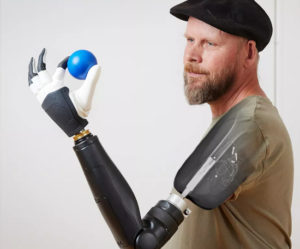Successful testing of the bionic hand has already been conducted on a patient who lost his arm above the elbow.

(Euronews – Camille Bello and Roselyne Min) — In a world first, surgeons and engineers have developed a new bionic hand that allows users with arm amputations to effortlessly control each finger as though it was their own body.
The innovation could revolutionize the way prosthetic limbs are designed and used, with scientists hailing it as a “major breakthrough”.
Prosthetic limbs can help people regain some functionality they lost after an amputation, but they can be challenging to control and sometimes unreliable, with only a limited range of motion.
However, for individuals with amputation higher up the arm, such as an above-elbow (transhumeral) amputation, things are more challenging.
In such cases, insufficient muscles remain to generate myoelectric signals to enable control of the lost arm and hand joints, meaning controlling the prosthetic limb in a way that feels natural is simply not possible.
A new era of bionic hands
The key to the new bionic hand – described in a study published in Science Translational Medicine – is a technique called neuromuscular reconstruction.
In this procedure, surgeons rewire the nerves in the residual limb so that they control different muscles. This allows users to generate more complex movements with the bionic hand, such as flexing and extending all five fingers to pick up small objects or type on a keyboard.
“So when the patient tries to do movements with his missing hand, those new muscular structures get activated,” Max Ortiz Catalan, Director of the Center for Bionics and Pain Research in Sweden, Head of Neural Prosthetic Research at the Bionics Institute in Australia, and Professor of Bionics at Chalmers University of Technology in Sweden, told Euronews Next.
“Then we put electrodes inside them so we can extract that information, use an artificial intelligence algorithm to look at those electrical pulses that come from all the different sources and learn what is the patient trying to do. And once it’s learned, which happens very quickly, then you can tell the prosthesis what to do,” he added.
Prosthetic limbs are typically attached to the body with a socket that compresses the residual limb making it mechanically unstable and uncomfortable. But the new bionic hand also tackles this problem.
Besides the neuromuscular reconstruction, the new implant also features a titanium implant that is placed within the residual bone connecting it to the body. This provides a more stable and comfortable attachment point for the hand, while also allowing for more natural movement.
“This is a major breakthrough in the field of bionic limbs,” said Ortiz Catalan as “it opens up the possibility of creating bionic hands that are as functional as natural hands.”
The achievement is based “on over 30 years of gradual development of the concept, in which I am proud to have contributed” said Dr. Rickard Brånemark, a leading expert on osseointegration for limb prostheses, who conducted the implantation of the interface.
‘Commercially available hopefully soon’
The new bionic hand has successfully been tested on a 52-year-old Swedish male patient, Tonney, who lost his arm above the elbow in a workshop. Tonney reportedly learnt to control the implant quickly and easily, as well as perform a variety of tasks with it, including moving the fingers.
In 2020, Tonney and the research team at Chalmers University of Technology participated in Cybathlon, an international athletic competition for people who use assistive technologies.
According to the research team, Tonney has used the prosthetics in his daily life for over three years now and is still using them.
The development of the new bionic hand is a new sign of hope for people with amputations. Close to 60 million people were living with limb amputation due to traumatic causes worldwide in 2017, according to the Institute for Health Metrics and Evaluation.
The device is currently in trials and the research team is actively working with surgeons and professionals in prosthetics around the world to bring this technology to patients.
“This combination [of surgical procedures and the bionic hand] was the first time. But now that we know it’s reliable and it can be conducive to better control, people are going to start implementing it,” Ortiz Catalan told Euronews Next.
“The new regulations in Europe have made it a bit more challenging to bring new products to the market. But we hope that we can bring this technology to more people relatively soon,” He added.
The research was led by Professor Max Ortiz Catalan, founding director of the Center for Bionics and Pain Research (CBPR) in Sweden, and the surgery took place at the Sahlgrenska University Hospital, Sweden, where CBPR is located.
For more and to watch a video on the bionic hand click here.
